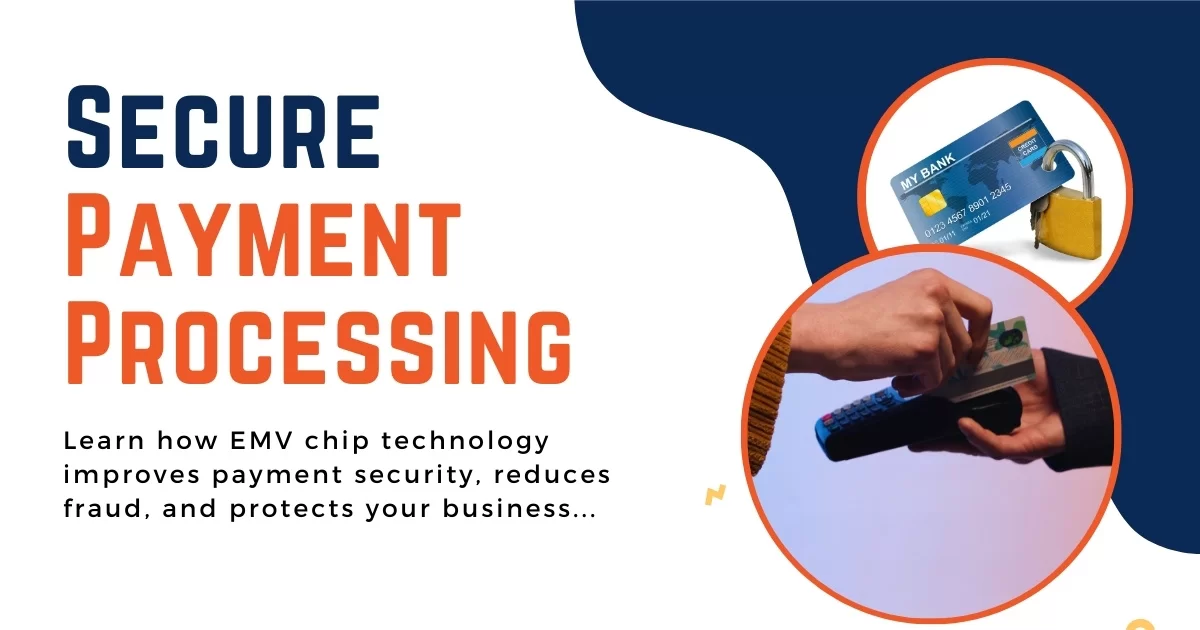
| April 13th, 2017 |
Why EMV Chip Technology Matters for Secure Payment Processing!
Summary:
This blog explains what EMV chip technology is, how it enhances payment security, and why it’s essential for businesses that accept in-person payments. It covers the key benefits, compliance requirements, costs of upgrading, and the financial risks of non-compliance, helping merchants make informed decisions about secure payment processing.
Introduction —
EMV stands for Europay, Mastercard, and Visa—the global standard for debit and credit card payments based on chip card technology. This embedded chip allows customers to insert their cards instead of swiping, offering an added layer of security and protection against payment fraud.
Introduced in the U.S. mainstream market around 2015, EMV chip cards have drastically reduced counterfeit fraud and are now a standard in most payment environments.
The Security Advantage of EMV Technology —
The primary benefit of EMV technology lies in its ability to significantly reduce card-present fraud. When a magnetic stripe card is swiped, the card transmits static data—the same card number is used for every transaction. If this data is intercepted or stolen, it can be used for fraudulent purchases.
EMV chips, on the other hand, generate a unique cryptographic code for each transaction, making it nearly impossible to duplicate or clone. This dynamic data security drastically reduces the chances of fraud.
Fact Check: While EMV cards are not entirely immune to fraud, they make counterfeit fraud significantly harder, especially in physical point-of-sale environments.
Key Benefits of EMV Technology:
With identity theft and cyber threats continuing to rise, adopting superior payment technology is no longer optional—it’s a necessity. EMV helps protect sensitive data during in-person transactions by making fraud extremely difficult. Here are some of the top benefits:
- Advanced authentication process: Transactions are verified through dynamic cryptograms and card verification methods (e.g., PIN or signature).
- Improved transaction security: Both online and in-store environments see fewer chargebacks and fraudulent transactions.
- Reduced risk of identity theft: Thanks to encryption and tokenization, sensitive cardholder data is harder to access or reuse fraudulently.
Does Your Business Need EMV?
If you’re unsure whether your business should adopt EMV, consider your industry. Businesses that handle in-person payments—such as restaurants, grocery stores, retail outlets, healthcare practices, and service providers—will benefit greatly from EMV-enabled terminals.
Even small businesses are expected to comply. As of the October 2015 EMV liability shift, the risk of fraudulent transactions shifted to merchants who haven’t upgraded their payment systems.
Helpful Insight: If your business uses a POS system or terminal without EMV support, you’re legally responsible for any fraud-related chargebacks that occur during card-present transactions.
Understanding the EMV Payment Process:
Here’s how a typical EMV transaction works:
- The customer inserts the EMV chip card into the terminal (instead of swiping).
- The card remains in the reader while the chip communicates with the terminal.
- A unique, encrypted transaction code is generated.
- Once verified, the screen prompts the customer to remove the card.
This “dip and wait” process is slightly slower than swiping but offers vastly improved security.
Costs of Upgrading to EMV —
Upgrading to EMV doesn’t have to be expensive. Your costs will depend on the scale and type of your business. While some merchants may only need a basic terminal, others may need to integrate EMV with their POS systems, accounting software (like QuickBooks), or CRMs.
Expert Tip: Work with a reputable merchant service provider to get tailored EMV integration at competitive prices—ensuring your hardware, software, and compliance needs are all addressed.
Why Non-Compliance Puts Your Business at Financial Risk —
Since the 2015 liability shift, card issuers are no longer responsible for certain types of fraud. If your business doesn’t support EMV, you’re fully liable for any in-person fraudulent transactions using magnetic stripe cards.
While smaller fraud losses might seem manageable, larger or recurring chargebacks can lead to:
- Hefty financial losses
- Damage to your merchant account reputation
- Risk of termination or higher processing fees
A Single Chargeback Can Hurt: Even one fraudulent transaction can negatively impact your bottom line and your relationship with your payment processor.
The Takeaway —
With the growing emphasis on data protection and secure payment experiences, EMV chip technology is no longer optional—it’s essential. It’s a proven, industry-backed solution for reducing fraud, protecting customer data, and staying compliant with global payment standards.
If your business hasn’t already made the switch, now is the time to take the next step toward smart, secure payment processing.
